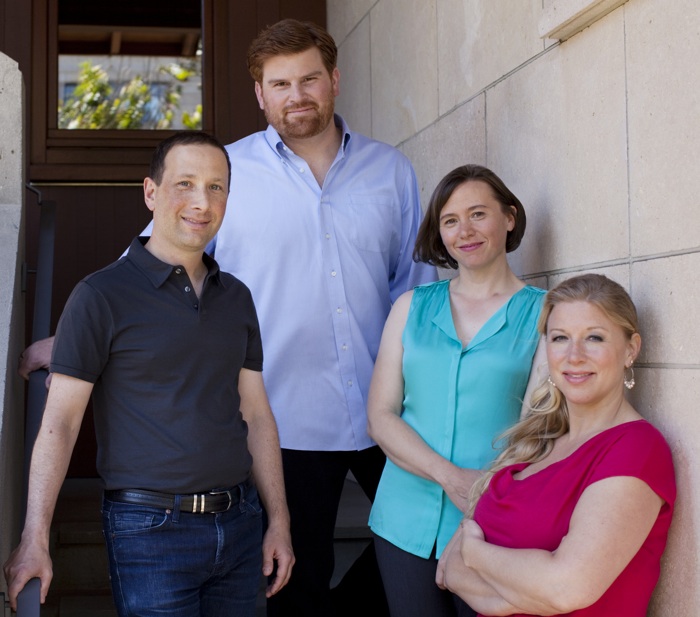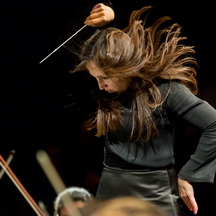Up-close with an extraordinary foursome
Last weekend, the Cypress String Quartet performed three salon concerts in intimate venues around the Bay Area. This is the second year of their Salon Series, designed to bring intense music into such close quarters with the audience that the experience borders on the visceral.
After one night each in Berkeley and San Francisco, on Sunday, January 26, their lush sound overflowed the small hall of the Woman’s Club of Palo Alto, reintroducing a concert that they first put together in 2001.
For the last fifteen years they have asked contemporary composers to write a reply to quartets from the established repertoire, what they refer to as their “Call and Response” commissioning program. In 2001 they commissioned Benjamin Lees to write a quartet inspired by Shostakovich’s String Quartet No. 11 and Benjamin Britten’s last work, his String Quartet No. 3. This resulted in Lees’ hugely successful String Quartet No. 5, and they performed all three works together.
I was particularly intrigued by this combination, because I had just had the pleasure of hearing the Alexander String Quartet perform Shostakovich’s earlier No. 8 along with that selfsame Britten No. 3, accompanied by explanations from musicologist Robert Greenberg (See Jan. 15 Piedmont Post). Sunday’s concert was a surprisingly different experience, partly because of a deeper understanding, partly because of the intimate hall (some could read the music over the violist’s shoulder!), and largely because of the personal approach of the Cypress Quartet.
Violinist Cecily Ward spoke before the Shostakovich. “This was originally the third Call and Response program, and it was very successful. It is amazing to come back to this after 12 years… We are most interested in the musical relationship between composers, and Shostakovich and Britten knew each other. There is also a special bond between composer and performer, and so we read everything we could about the Beethoven String Quartet, the group that Shostakovich wrote this piece for. This piece has seven short movements that form an incredible narrative. Moments are like head banging, and then the second movement features second violin in a short motif, only two notes incessantly, and it underlies everything else.”
While the Alexander Quartet was fiercely tragic, capturing Shostakovich in his political milieu, the Cypress Quartet delineated those bonds of friendship. This quartet was dedicated to the memory of Shostakovich’s childhood friend, Vasily Shirinsky, the second violinist of the Beethoven Quartet, and written one year after his death. “The second violin part was tough enough to honor him, but easy enough for his replacement!” quipped Ward.
And indeed, Tom Stone, the Cypress’ second violinist, shone in this quartet. Shostakovich’s intensity kept us on our seats throughout, but there was also a childlike simplicity and humorous whips. Cellist Jennifer Kloetzel propelled them in chords that were violently front-loaded and then released into long harmonies. At other times Ward took a manic perpetuum mobile, high and fast, and then passed it on to Ethan Filner, their formidable violist. They ended, as an elegy should, on a stunning high violin passage that dissipated into silence.
Second violinist Tom Stone continued, “So Shostakovich and Britten were dear, dear friends. It seems unlikely, in the heart of the Cold War, but they eventually met on vacations. And Shostakovich taught his students Britten’s War Requiem as ‘one of the great pieces of music.’ When we were a young quartet we were very enamored with the Amadeus Quartet, the quartet that premiered Britten’s quartets. We went to London and studied with them for two weeks. They coached us and told us stories about Britten. They had visited him in the hospital—he had heart surgery, and it didn’t go well, and they encouraged him to write them another quartet. ‘It’s only four staves, not like writing for orchestra,’ they teased. He had had a stroke and had to write with his left hand, but he wrote it for them.”
Britten wrote his third and final quartet as homage to the Amadeus. Each of the first four movements refers to them, and the Cypress brought their portraits to life. After sere pairings, the boisterous exchanges of the second were “an ostinato for the stubborn cellist,” according to Stone, “and viola squeals from the wrong side of the bridge were a joke on the violist.” That jarring fourth movement was also to honor Shostakovich, whose death the year before had crushed Britten. “And the third was an homage to the first violinist, a Falstaff figure with an oversized person and persona.”
I later asked Ward about the violence of those high passages, and she told me that the Amadeus violinist told her to “really attack the strings. His big arm shook!” That unearthly language of birds was also Britten’s apotheosis, and Ward well knew it, as her eyes were closed as she played.
Sitting nearly onstage, it was sometimes hard to tell where the music left off and perception or memory began.
After that amazing pairing of works, Kloetzel took the stage to talk about Benjamin Lees. “For me it’s often the personal stories that bring the music off the page. We worked closely with Ben from 2001 right up until his death in 2010… Once he called me and said, ‘I’ve just finished the most delightful movement. It goes like the wind! I hope you can play it.’ And it does feel like the wind, or a puff of smoke. And then he rewrote it faster…twice!”
There were deep fifths and explosive unisons, chords turned into bulwarks of sound with double stops, low viola passages, telegraphic and creepy… and unmistakable moments of 1950s spy movies! And throughout, vibrant colors and rhythms, performed with freshness and immediacy.

The busy Cypress Quartet will be appearing in several small venues around the Bay Area in February and March, an opportunity to hear this extraordinary group up close before their tour to the East Coast.
After appearances in 15 schools around the Bay Area, they will bring their Call & Response program to SF’s Marines Memorial Theatre on Friday, March 14, starring a premiere by American composer George Tsontakis.
See cypressquartet.com for their calendar.
–Adam Broner
Photo of the Cypress String Quartet by Gregory Goode. Pictured from left are: Tom Stone (second violin), and Ethan Filner (viola), Cecily Ward (first violin), and Jennifer Kloetzel (cello).
